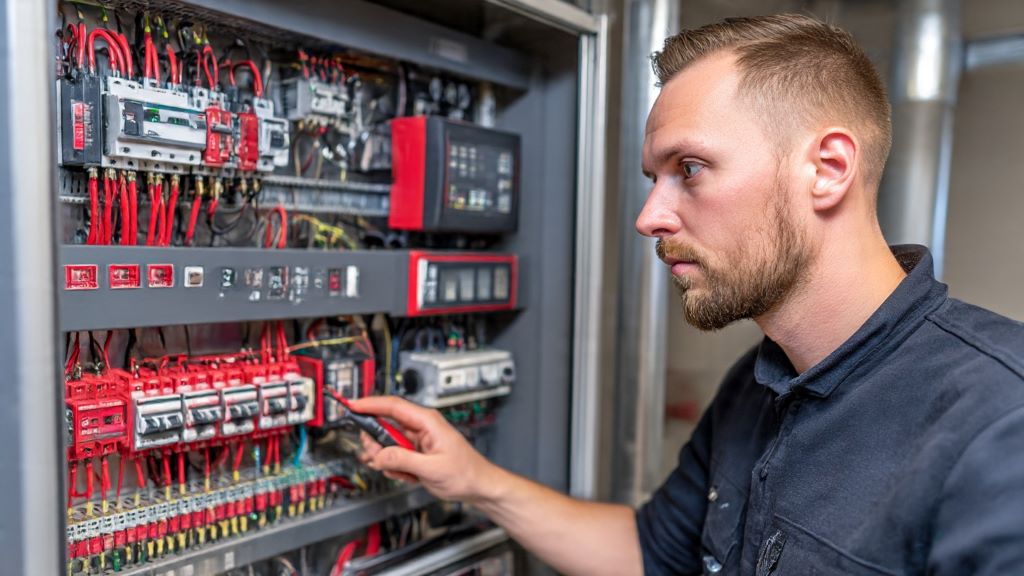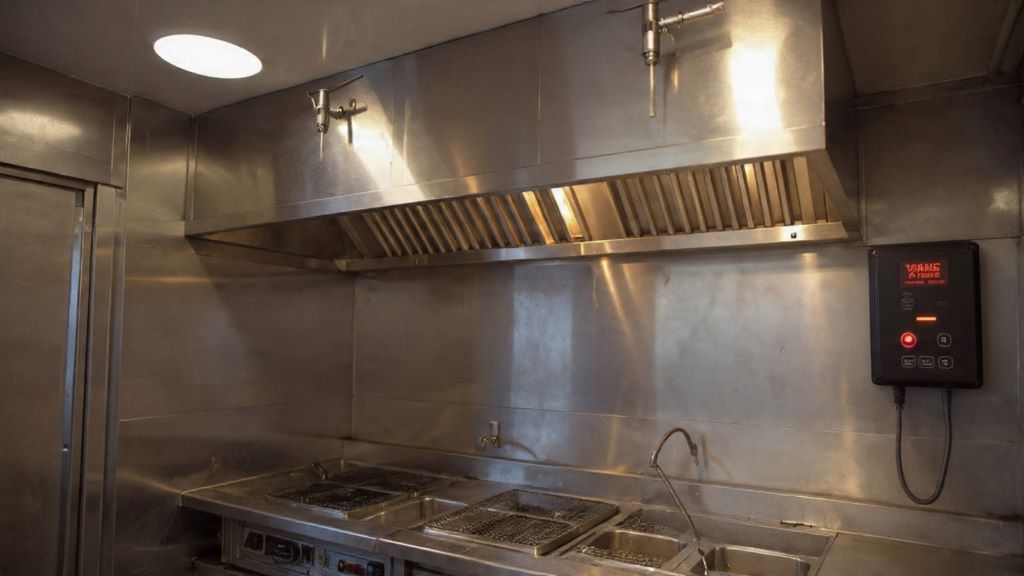When a fault light appears on your commercial kitchen’s fire suppression system, it can create immediate concerns about safety and compliance. These warning indicators are designed to alert you when something needs attention. Understanding what causes these alerts and how to address them can help you maintain a safe working environment. According to experts at Roof Master Construction, properly functioning fire suppression systems are essential for protecting both your staff and your investment.
Commercial kitchens face unique fire hazards due to high-temperature cooking equipment and grease buildup. Therefore, suppression systems serve as your first line of defense against potentially devastating fires. When a fault light illuminates, it signals that your system may not function properly during an emergency. This makes quick diagnosis and resolution critical for maintaining safety standards and meeting local fire codes.
Understanding Kitchen Hood Fire Suppression Systems
Before diving into troubleshooting, it helps to understand how these systems work. Kitchen hood fire suppression systems are specifically designed to detect and extinguish fires that start in cooking appliances. They typically consist of detection devices, nozzles, chemical tanks, and a manual pull station. When heat reaches a certain threshold, the system automatically discharges a wet chemical agent that suppresses flames and prevents re-ignition.
Modern systems use sophisticated monitoring technology to ensure readiness at all times. Additionally, they include various sensors that constantly check system pressure, tank levels, and electrical connections. When any component falls outside normal parameters, the control panel activates a fault indicator. This proactive monitoring helps prevent system failures during actual emergencies.
Common Causes of Fault Light Activation
Several issues can trigger a fault light on your suppression system. Understanding these common causes can help you identify problems quickly and determine whether you need professional assistance.
Low system pressure ranks among the most frequent culprits. The suppression system maintains specific pressure levels to ensure proper discharge during activation. When pressure drops below the required threshold, the fault light illuminates. This can happen due to small leaks, temperature changes, or aging components.
Electrical connection problems also commonly trigger fault indicators. Loose wiring, corroded terminals, or power interruptions can disrupt the system’s monitoring capabilities. Even minor electrical issues can cause the control panel to register a fault condition.
Tank positioning or tamper switches represent another common issue. Most systems include switches that detect when someone moves or tampers with critical components. If a tank shifts slightly or someone accidentally bumps a tamper switch, the fault light activates as a precautionary measure.
Detection link issues can also cause alerts. The fusible links that trigger automatic activation can become damaged, corroded, or improperly positioned over time. When the system cannot verify link integrity, it signals a fault condition.
Initial Troubleshooting Steps
When you notice a fault light, start with these basic troubleshooting steps before calling a professional. However, remember that some repairs require certified technicians due to safety regulations and warranty considerations.
First, check the control panel display for specific error codes or messages. Many modern systems provide detailed information about the nature of the fault. Write down any codes you see, as this information proves valuable for technicians.
Next, visually inspect all visible components. Look for obvious issues such as disconnected wires, moved tanks, or damaged detection links. Sometimes the problem is immediately apparent and easy to document.
Verify that the system has adequate power. Check circuit breakers and ensure the control panel shows normal power indicators. Power fluctuations or tripped breakers can cause temporary fault conditions.
Examine pressure gauges on chemical tanks. The gauge needle should rest within the green zone. If pressure appears low, this likely explains the fault condition. Nevertheless, never attempt to repressurize tanks yourself, as this requires specialized training and equipment.
When to Call a Professional
Certain situations demand immediate professional attention. According to the National Fire Protection Association, only certified professionals should perform repairs and maintenance on fire suppression systems. Attempting DIY repairs can void warranties, violate fire codes, and compromise safety.
Contact a certified technician immediately if you detect any chemical leaks or strong odors near the system. Chemical agents used in suppression systems require careful handling and proper disposal procedures.
Similarly, electrical issues beyond simple breaker resets require professional expertise. Working with electrical components in suppression systems poses both shock hazards and the risk of accidental discharge.
If you cannot identify an obvious cause for the fault light, professional diagnosis becomes necessary. Technicians have specialized testing equipment that can pinpoint subtle issues invisible during visual inspection.
Furthermore, any system that has partially discharged needs professional service before returning to operation. Even minor discharges require tank refilling, system testing, and often component replacement.

Preventive Maintenance to Avoid Fault Lights
Regular maintenance represents the best strategy for preventing unexpected fault lights and ensuring reliable system performance. Most jurisdictions require professional inspections at least twice annually for commercial kitchen suppression systems.
During professional maintenance visits, technicians inspect all system components thoroughly. They check pressure levels, examine detection links, test electrical connections, and verify proper nozzle positioning. These inspections often identify potential issues before they trigger fault conditions.
Between professional visits, kitchen staff should conduct simple visual checks. Look for obvious signs of damage, verify that nothing obstructs nozzles, and ensure tanks remain properly secured. These quick checks take minimal time but can reveal developing problems.
Keep the area around your suppression system clean and accessible. Grease buildup can affect detection links and other components. Moreover, ensuring clear access helps technicians perform maintenance more efficiently.
Document all maintenance activities and system alerts. This record keeping helps identify recurring issues and proves valuable for compliance inspections. Many modern control panels store fault history, but maintaining separate records provides additional protection.
Resetting the Fault Light
After addressing the underlying issue, you need to reset the fault light. However, never reset a fault indicator without first identifying and resolving the problem that caused it. Resetting without repair simply masks potentially dangerous conditions.
The reset procedure varies by manufacturer and model. Most systems include a reset button on the control panel. Some require specific button sequences or temporary power disconnection. Always consult your system’s manual for the correct reset procedure.
If the fault light returns immediately after resetting, this indicates the underlying problem remains unresolved. Repeated fault indicators without identifying the cause suggest you need professional diagnosis.
After successful reset, monitor the system closely for several days. Occasional checks confirm that the fault has truly been resolved and the system maintains normal operation.
Understanding System Regulations and Compliance
Fire suppression systems must comply with various local, state, and federal regulations. The National Fire Protection Association’s NFPA 96 standard provides comprehensive guidelines for commercial kitchen ventilation and fire suppression.
Most jurisdictions require regular inspections by certified professionals. These inspections typically occur semi-annually, with detailed documentation submitted to local fire marshals. Operating with an active fault light may violate these requirements and could result in citations or operational shutdowns.
Insurance companies also have specific requirements regarding fire suppression system maintenance. Failure to maintain systems properly can affect coverage or claims processing after incidents. Therefore, addressing fault lights promptly protects both safety and business interests.
Conclusion
A fault light on your kitchen suppression system requires prompt attention but need not cause panic. By understanding common causes and following proper troubleshooting procedures, you can often identify issues quickly. Remember that professional service remains essential for repairs, maintenance, and ensuring compliance with safety regulations. Regular preventive maintenance reduces the likelihood of unexpected faults and keeps your system ready to protect your kitchen when needed. Taking fault indicators seriously and addressing them promptly demonstrates your commitment to safety and helps protect your business, employees, and customers from fire hazards.
Frequently Asked Questions
Can I continue operating my kitchen with a fault light showing?
While technically possible in many cases, operating with an active fault light is not recommended and may violate local fire codes. The fault indicates your suppression system may not function properly during an emergency. Contact a certified technician immediately to assess and resolve the issue. Most jurisdictions require fully functional suppression systems during business operations.
How often should kitchen suppression systems be professionally inspected?
Most codes require professional inspections at least twice annually, typically every six months. However, some jurisdictions or insurance policies may require more frequent inspections. High-volume kitchens might benefit from quarterly inspections. Always check your local requirements and consult with your fire suppression service provider about the optimal inspection schedule for your specific operation.
What does it cost to repair a kitchen suppression system fault?
Repair costs vary significantly depending on the issue. Simple fixes like resetting a tamper switch might cost a basic service call fee, typically between $150 and $300. However, more complex repairs involving component replacement, tank refilling, or electrical work can range from $500 to $2,000 or more. Regular maintenance helps prevent costly emergency repairs.
Can low temperatures cause false fault alerts?
Yes, temperature fluctuations can affect system pressure and trigger fault lights. Cold weather may cause pressure drops in tanks, while extreme heat can affect electronic components. These temperature-related faults often resolve when conditions normalize, but you should still have the system checked to ensure it maintains proper pressure ranges year-round.
Who is qualified to repair kitchen fire suppression systems?
Only factory-trained and certified technicians should repair fire suppression systems. Look for professionals certified by organizations like the National Association of Fire Equipment Distributors (NAFED) or those holding manufacturer-specific certifications. These technicians have the training, tools, and authorization to maintain and repair systems properly while maintaining warranties and compliance.
Related Topics:









